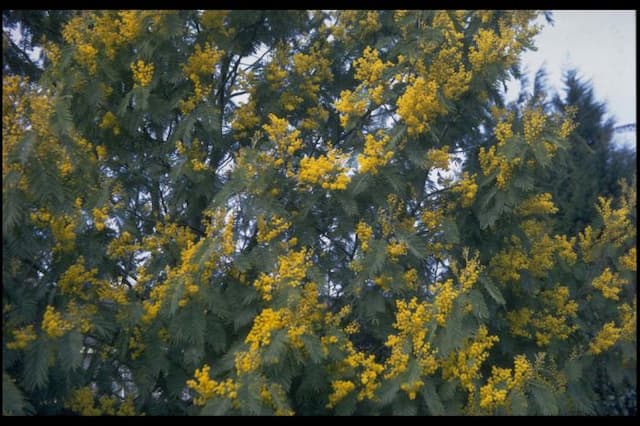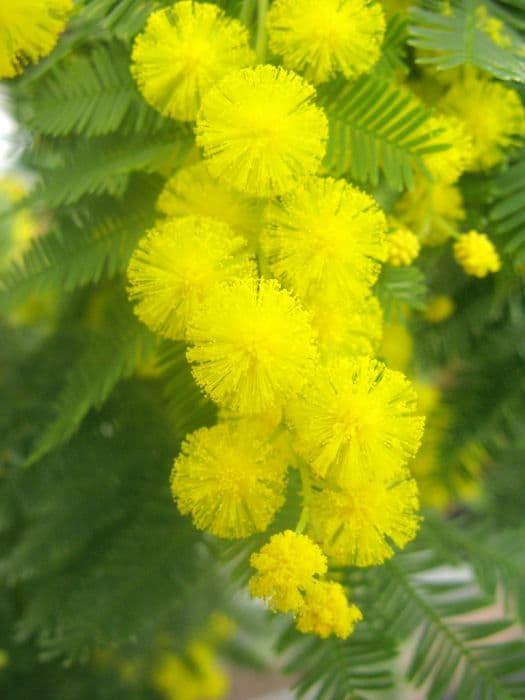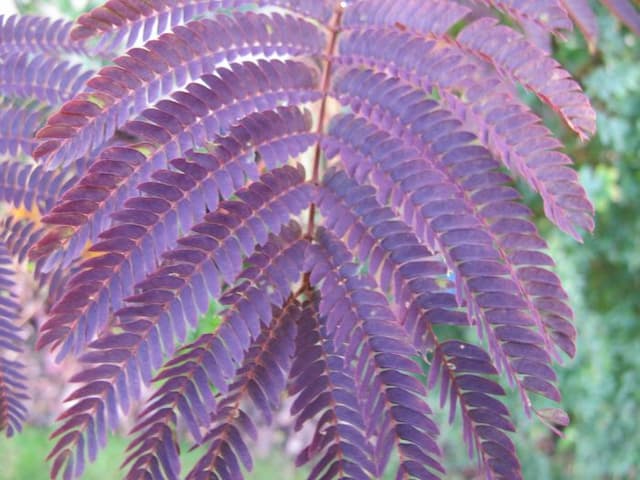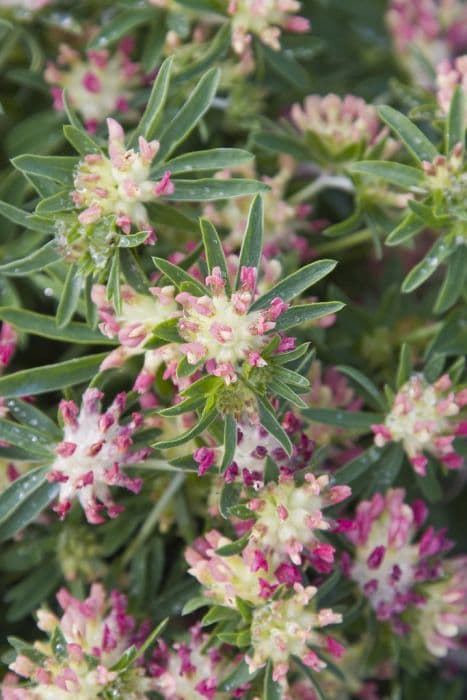Moroccan broom Argyrocytisus battandieri 'Yellow Tail'

ABOUT
The Argyrocytisus battandieri 'Yellow Tail', commonly known as Moroccan Broom or Pineapple Broom, strikes a stunning presence with its distinctive silvery-gray, trifoliate leaves that give it an almost feathery appearance. The foliage provides a beautiful contrast against the showy, conical clusters of bright yellow, pea-like flowers that emit a sweet, pineapple-like fragrance when they bloom. These delightful flowers form dense inflorescences that cascade attractively, creating a vibrant splash of color that is particularly noticeable when the plant is in full bloom. The bark of the Moroccan Broom is quite smooth, enhancing its elegant silhouette. The overall form of the plant has a rounded and bushy aspect, giving it an alluring and full-bodied look that makes it a captivating addition to any garden setting.
About this plant
 Names
NamesFamily
Fabaceae.
Synonyms
Moroccan Broom, Pineapple Broom, Atlas Mountain Broom.
Common names
Cytisus battandieri, Genista battandieri, Laburnocytisus battandieri.
 Toxicity
ToxicityTo humans
The plant commonly known as Moroccan broom (Argyrocytisus battandieri 'Yellow Tail') has not been widely reported as toxic to humans. However, as with many plants, some individuals may experience allergic reactions or skin irritation upon contact with this plant. It is always advisable to exercise caution and avoid ingesting parts of plants that are not known to be edible, since there may be individual variations in reactions.
To pets
Moroccan broom (Argyrocytisus battandieri 'Yellow Tail') is not commonly known to be toxic to pets. However, it is generally recommended to prevent pets from ingesting plants, as they might cause gastrointestinal upset or other issues due to the plant's natural defense mechanisms or individual sensitivity in animals. Close observation is advised if a pet has consumed any part of this plant, and veterinary assistance should be sought if adverse symptoms are observed.
 Characteristics
CharacteristicsLife cycle
Perennials
Foliage type
Deciduous
Color of leaves
Green
Flower color
Yellow
Height
10-15 feet (3-4.5 meters)
Spread
6-10 feet (1.8-3 meters)
Plant type
Shrub
Hardiness zones
7
Native area
Morocco
Benefits
 General Benefits
General Benefits- Ornamental Value: The Moroccan Broom, with its striking yellow flowers and silvery-green foliage, serves as an ornamental addition to any garden or landscape.
- Attracts Wildlife: With its vibrant blooms, it provides nectar and attracts pollinators like bees and butterflies, enhancing biodiversity.
- Drought Tolerance: It is highly adapted to dry conditions, making it suitable for xeriscaping or regions with water scarcity.
- Low Maintenance: Requiring minimal care once established, it's ideal for gardeners looking for plants that do not demand frequent attention.
- Soil Adaptability: It is adaptable to a range of soil types, although it prefers well-drained conditions, which makes it versatile for different garden settings.
- Fast Growth: Moroccan Broom has a rapid growth rate that allows for quick establishment and filling in of garden spaces.
- Screening and Privacy: Its growth habit and size make it an excellent choice for use as a natural screen or hedge for privacy.
- Architectural Interest: With its unique form and color, it adds architectural interest to garden designs.
- Scented Flowers: The flowers produce a pleasant, sweet scent that adds an olfactory dimension to the garden experience.
- Seasonal Interest: It blooms in late spring to early summer, providing a burst of color when many other plants have yet to flower.
 Medical Properties
Medical PropertiesThis plant is not used for medical purposes.
 Air-purifying Qualities
Air-purifying QualitiesThis plant is not specifically known for air purifying qualities.
 Other Uses
Other Uses- The Moroccan Broom can be used as an ornamental specimen in drought-resistant gardens, due to its low water requirements once established.
- Its dried flowers can be utilized in potpourri mixes, adding a sweet, pineapple-like fragrance to the blend.
- The plant's silvery-green foliage can be used in floral arrangements, providing a unique texture and color contrast.
- Wood from the Moroccan Broom can be repurposed for small woodworking projects, like crafting walking sticks or decorative items.
- The dense foliage of the Moroccan Broom offers shelter and nesting sites for birds in a garden setting.
- Creative gardeners might train and prune the Moroccan Broom into a living fence or privacy screen.
- Moroccan Broom's bark and branches can be used in crafting natural dyes for fabrics or yarn, though this is a less common practice.
- The plant can be used in erosion control efforts on dry, sloping landscapes due to its root system that helps stabilize the soil.
- As a bee-friendly plant, the Moroccan Broom can be planted to support local bee populations and enhance pollination in gardens.
- In artistic applications, the striking form and color of the Moroccan Broom can be a subject for photography or botanical illustration.
Interesting Facts
 Feng Shui
Feng ShuiThe Moroccan Broom is not used in Feng Shui practice.
 Zodiac Sign Compitability
Zodiac Sign CompitabilityThe Moroccan Broom is not used in astrology practice.
 Plant Symbolism
Plant Symbolism- Exotic Essence: As a plant native to Morocco, the Yellow Tail reflects an essence of exoticism, suggesting a sense of mystery and unique beauty.
- Rarity: Given it is not widely found, Yellow Tail can symbolize something rare and valuable, representing the beauty in scarce and uncommon traits.
- Sunshine and Joy: The bright yellow flowers of the Yellow Tail evoke the warmth and vitality of sunshine, symbolizing happiness and joy in one's life.
 Water
WaterThe Moroccan Broom should be watered deeply but infrequently, allowing the soil to dry out between waterings. During the active growing season in spring and summer, water approximately every 7 to 10 days, providing about 1-2 gallons depending on the size and maturity of the plant. In the fall and winter, reduce watering to every 2 to 3 weeks or less, monitoring the soil moisture to prevent overwatering. Overwatering can lead to root rot, so it is crucial to ensure proper drainage.
 Light
LightThe Moroccan Broom prefers full sun to thrive. It should be placed in a location that receives at least 6 to 8 hours of direct sunlight daily. Avoid shaded areas as inadequate light can hinder flowering and cause the plant to become leggy.
 Temperature
TemperatureMoroccan Broom does well in a range of temperatures but prefers a mild to warm climate. It can tolerate temperatures as low as 15°F for short periods but is best kept in conditions above freezing. The ideal temperature range for optimal growth is between 50°F and 80°F. Extreme heat or cold can be detrimental to the plant's health.
 Pruning
PruningPruning the Moroccan Broom is necessary to maintain its shape and encourage new growth. Prune immediately after flowering, typically in late spring or early summer, by cutting back the spent flower stems and removing any dead or damaged wood. Biennially, perform a more substantial pruning to rejuvenate older plants and stimulate robust new growth. Avoid heavy pruning in the fall or winter, which can harm the plant.
 Cleaning
CleaningAs needed
 Soil
SoilThe Moroccan Broom 'Yellow Tail' prefers well-drained soil with a slightly acidic to neutral pH of 6.0 to 7.5. A soil mix composed of two parts loam, one part peat or sand, and one part compost or well-rotted manure will provide the best growing medium.
 Repotting
RepottingThe Moroccan Broom 'Yellow Tail' generally does not need to be repotted often, but it can be done every 2-3 years to refresh the soil and accommodate its growth.
 Humidity & Misting
Humidity & MistingThe Moroccan Broom 'Yellow Tail' tolerates a wide range of humidity levels but prefers moderate humidity and does not require high humidity to thrive.
 Suitable locations
Suitable locationsIndoor
Ensure full light, minimal watering, and protect from drafts.
Outdoor
Plant in full sun, shelter from strong winds, and prune after flowering.
Hardiness zone
7-10 USDA
 Life cycle
Life cycleThe Moroccan broom (Argyrocytisus battandieri 'Yellow Tail') begins its life cycle when seeds germinate in spring, provided they are in well-drained soil and have been stratified if necessary. As a young plant, it produces a small number of trifoliate leaves and begins to establish its root system. As it matures, it develops into a large, upright shrub with silvery-green, trifoliate leaves and a more extensive root system that helps it survive in dry conditions. The Moroccan broom typically flowers in early summer, producing dense, cone-shaped clusters of bright yellow, pineapple-scented flowers that attract various pollinators. After pollination, the flowers develop into seed pods, which eventually dry and open to release seeds for the next generation. The plant has a lifespan of about 10-20 years, during which it can reach a size of 2-4 meters tall and across, and it can withstand short periods of cold in winter.
 Propogation
PropogationPropogation time
Spring to Early Summer
Propogation: The Moroccan Broom, scientifically known as Argyrocytisus battandieri 'Yellow Tail', is often propagated through semi-hardwood cuttings. The most popular method of propagation for this plant involves taking cuttings from new growth that has started to harden off, usually in late summer. To do this, select a healthy branch about 6 to 8 inches long and cut it just below a node, where the concentration of growth hormones is higher. It's beneficial to dip the cut end into a rooting hormone powder to encourage root development. Then, plant the cutting in a pot filled with a well-draining soil mixture. The cutting should be kept in a warm environment with indirect sunlight and consistently moist soil to foster root growth. Within a few weeks to months, the cutting will develop roots and can eventually be transplanted into the garden.









